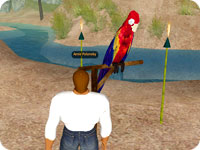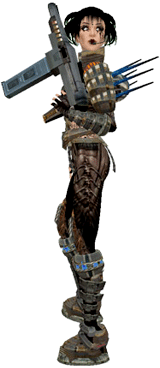Meet the Residents
Chip Matthews, Nathan Keir, and Foxy Xevious all contribute something different to the Second Life experience, but they share a mutual love of the boundless creativity offered by the game, as well as the virtually limitless opportunities for social interaction.
Chip Matthews (More Info)Matthews signed up in May 2003, during the last month of open Beta testing. “I’d read an article about it before it hit alpha testing and knew it sounded like something I’d love to be involved with,” he recalls. “When I heard that it had entered open Beta, I came running.”
He makes skins that other residents purchase, estimating that he’s earned $10,000-$15,000 so far. He was the first player to start making full body skins, but he’s no longer the only one. “I’m not complaining, though,” he says. “I still do $500-$1,000 in sales per month, and I love seeing the beautiful work being done by some of the other skinners. The amount of talent out there is staggering.”
Matthews starts work on a skin by obtaining a photograph of the player. From there, he says, “it’s a fun challenge to see how realistic I can make it look without going too far. There’s a fine line between attractive realism and the ‘uncanny valley’ effect.”
Japanese roboticist Masahiro Mori coined the term “uncanny valley” in the 1970s, after his research showed that the more anthropomorphic a robot’s features, the greater the empathic response of the viewer. However, when those features become too humanlike, most people think they look strange, producing a drop in emotional response known as the “uncanny valley.”
Matthews says that his participation in Second Life “has been a very eye-opening experience. The game shatters a lot of stereotypes. I’ve met everyone from retirees with irrepressible and extremely silly inner children to well-known people in the gaming industry. There are CEOs of big corporations who come to Second Life to get away from the pressures of their real lives, while people with disabilities find that the game frees them from their limited physical abilities.”
Nathan Keir (More Info)Playing under the name Kermitt Quirk, Keir has been a Second Life resident since September 2004. He says that “the thing that really hooked me was the scripting. Nothing else I’ve seen gives the users that sort of control over a live 3D environment.” A programmer by day, he notes that the game’s tools enable him to “produce amazing stuff in a fraction of the time it would take in a standard programming language.”
He recalls that the inspiration for Tringo came from the bingo games he would host within Second Life. Rather than fill a board by marking numbers, however, in Tringo the player grabs the shape that appears every ten seconds and tries to fit it into her board, earning points every time a 2x2, 2x3, or 3x3 object is completed.
“When I created it,” he says, “I never realized I’d hit on just the right combination of features to make such a unique game. I certainly didn’t set out with that purpose in mind.” He notes that his profits from the sale of Tringo boards in Second Life have exceeded two million Linden dollars, or approximately $7,780, but he can’t say how much he made from selling the rights to the game.
Foxy Xevious (More Info)Admitting that she’s “not much of a gamer,” Xevious joined Second Life in May 2004. She quickly became hooked on its creative possibilities, noting that “Second Life is beyond a game; it’s a tool for artistic freedom that brings people together. I love how people can create pretty much anything they want, even things they think aren’t possible.”
After working on two games within Second Life — the Halloween-themed adventure Sim Horror and the Unreal-inspired U:SL — Xevious decided to delve into the world of machinima, which is the process of making movies out of the level-building tools that come with many games. In her case, Xevious and her partner, Jimmy Thomson, use Second Life’s tools to build sets, props, and costumes and then recruit other characters to play roles in their movies.
Thomson “has bent a lot of rules graphically in Second Life,” according to Xevious. “He’s done what people thought could never be done with shadows and reflections.”
Xevious and Thomson’s first machinima is a western-themed effort called “Silver Bells and Golden Spurs.”

Polly Want an Avatar? You’ll meet this colorful parrot during your introduction to the game.

Not Quite a League Under the Sea. Touring Atlantis in a submarine.

Pimp My Pad. One of the many fascinating homes built by actual Second Life residents.

Giddyup! One of many creatures available for you to ride.
“Second Life actually began as a series of technology experiments during 2000 and early 2001,” recalls Ondrejka. “These tests proved that we could create a highly dynamic world based on physical simulation and cellular automata that was interactively streamed to a computer over a consumer broadband Internet connection.
“Our early versions of the world included a forest fire and wave simulations that correctly propagated over multiple simulation machines. These early tests quickly demonstrated the need for creation tools. Once we started creating human artifacts, the vision for Second Life rapidly shifted from a living, outdoor environment to a more avatar-centric world.” The game officially launched in June 2003.
The idea of allowing players to own what they create came about in the Fall of 2003, during a roundtable discussion. “As we spoke about residents building the world,” Ondrejka says, “Lawrence Lessig pointed out that to truly maximize growth and innovation, ownership is critical. Hernando de Soto’s book ‘The Mystery of Capital: Why Capitalism Triumphs in the West and Fails Everywhere Else’ was making the office rounds at the same time and reinforced this thinking, so we made the decision to allow residents to own their creations.”
Since then, Linden Lab has made incremental tweaks to the game, improving its economic model and refining the graphics. Now players can place custom animations on their avatars and stream audio and video files to other residents who stop by their parcels of land. “Second Life has definitely proven that user creation can drive a vibrant and interesting world,” Ondrejka remarks. “At the same time, it’s a very young world, and we still have many ways to make it better.”
To learn more about Second Life, explore the official web site or the Wikipedia entry devoted to it.

- Mac OS X version 10.4.11
- 1GHz PowerPC G4 processor
- 512MB of RAM
- GeForce 2 or ATI Radeon 9200 graphics or higher (may not be compatible with Intel graphics)
- Broadband Internet connection (DSL/Cable Modem/LAN)
